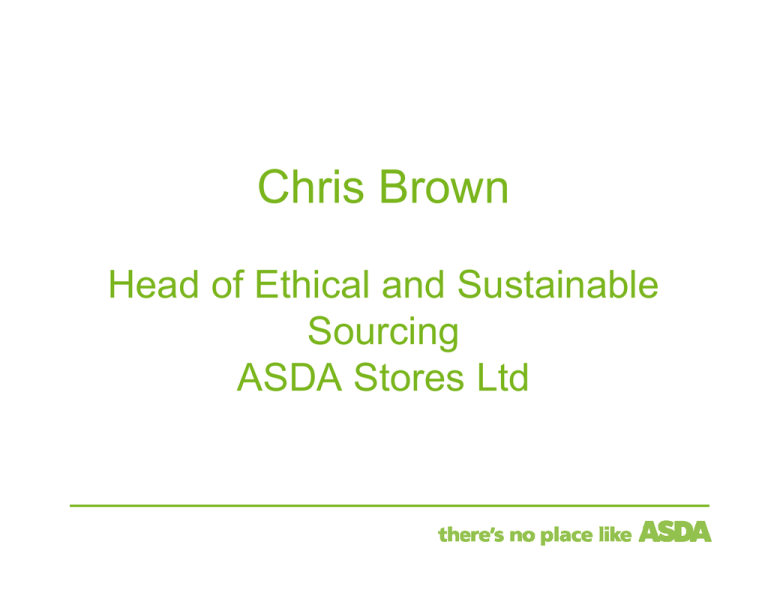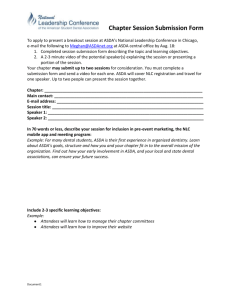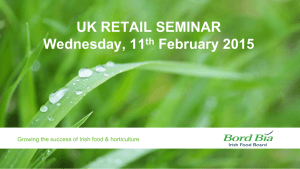Chris Brown Head of Ethical and Sustainable Sourcing ASDA Stores Ltd
advertisement

Chris Brown Head of Ethical and Sustainable Sourcing ASDA Stores Ltd Our Purpose “To make goods and services more affordable for everyone” What we are doing? • We have a plan and strategy that is working • Rebooting our business to meet the new customer agenda • Staying true to what we are • Championing EDLC Long term grocery growth trends Market growth slows slightly despite inflationary pressures 8 % change vs last year 7 6 5 4 3 2 1 98 99 00 01 02 03 04 05 06 07 0 Grocery Market 12we Grocery 12we 05 Oct 2008 08 Food Inflation 10 9 8 7 6 5 4 3 2 1 0 9.0 9.3 8.1 6.8 5.0 4.6 4.5 2.9 Average Price Paid Per Pack Grocery 12we 05 Oct 2008 05-Oct 10-Aug 13-Jul 2.6 15-Jun 18-May 20-Apr 23-Mar 2.5 Inflation 5.2 5.4 3.6 3.3 3.2 24-Feb 5.8 07-Sep 4.9 4.4 4.4 3.8 27-Jan Change Year on Year % Rate of increase has started to slow Market shares and growth rates Value oriented retailers still leading the pack in spend growth Till Roll Market Year on Year Sales Growth % Till Roll Market Share % Tesco 22.8 Asda 12.4 Sainsbury's 11.4 Morrisons 8.1 Aldi 22.1 Iceland 11.8 Lidl 9.8 Morrisons 9.6 Co-Op 3.1 Asda Somerfield 2.8 Sainsbury's 5.6 Waitrose 2.7 Tesco 5.5 Aldi 2.2 Netto Lidl 1.7 Co-op Iceland 1.2 Waitrose Netto 0.5 9.0 3.6 2.4 1.6 Somerfield 0.1 6 Till Roll 12we 05 Oct 2008 Slight skew to less affluent shoppers but ASDA is essentially a mass market retailer 11 16 11 18 14 22 15 15 15 17 15 17 16 17 16 15 17 25 22 23 Class AB Source: TNS Till Roll – 13 July 2008 24 23 22 22 24 23 23 24 24 24 19 18 10 10 11 22 Class C1 28 22 18 16 14 19 Class C2 27 23 Total Co-op 26 Somerfield 17 26 Lidl 19 Asda 21 27 Aldi 26 Morrisons 27 Tot Grocers 24 20 20 19 Tesco 27 Sainsbury Waitrose 30 19 31 28 37 21 20 26 30 20 Iceland 11 13 Farm Foods 9 13 Netto 14 Class D 14 Tot Indepts 17 M&S Spend Profile % Till Roll Demographics Ranked on Social Class - 4 w/e Jul 13 2008 24 Class E ASDA large family bias – but almost 50% spend is from 1 – 2 persons households Till Roll Demographics Ranked on Household Size - 4 w/e Jul 13 2008 7 8 15 16 15 6 9 6 5 14 13 9 12 12 16 16 17 15 35 35 38 42 30 32 28 26 30 13 19 23 19 22 Lidl 18 45 1 Member HHs 2 Member HHs 4 Member HHs 5+ Member HHs Source: TNS Till Roll – 13 July 2008 13 43 42 Aldi 19 23 38 37 Sainsbury 17 30 19 17 Morrisons 20 35 20 Farm Foods 36 35 Netto Asda 16 29 21 Tot Grocers 31 20 Tesco 21 18 18 17 4 11 7 M&S 15 9 Waitrose 16 11 Total Co-op 18 20 10 Tot Indepts 18 9 10 Iceland Spend Profile % 21 13 Somerfield 11 3 Member HHs ASDA also bias to families – but almost 60% spend is from households without children 4 4 14 12 12 16 14 12 13 12 18 Source: TNS Till Roll – 13 July 2008 12 12 12 11 2 11 7 2 7 8 75 75 76 83 66 66 69 Sainsbury 75 80 71 65 1 Child HHs 4 10 13 71 No Children 4 9 14 Morrisons 62 6 7 15 Farm Foods 60 16 Netto 57 15 Tot Grocers 16 Tesco 19 Iceland 19 16 3 9 M&S 5 Waitrose 7 Lidl 5 Total Co-op 5 Tot Indepts 7 Somerfield 8 Aldi 6 Asda Spend Profile % Till Roll Demographics Ranked on No. of Children - 4 w/e Jul 13 2008 2 Child HHs 3+ Child HHs Looking outside the ASDA bubble … … we are now in recession… • UK Inflation +5% • 1.8m people unemployed • 1.2m homes in negative equity risk • House prices down 15% …impacting businesses close to us Despite some reprieve in mortgage, fuel and food prices customer confidence is still low Source: Pulse of the Nation However grocery basket size continues to grow; but on a backdrop of fewer trips across a bigger number of stores Yr on Yr Growth % 7 6 5 4 3 2 1 0 -1 -2 -3 -4 6.0 1.9 0.9 -2.8 Store Repertoire Trip Frequency Source: TNS Basket Size Items per basket Meal preparation and consumption has become more fluid and less formal % eating or drinking, in or out of home, by time of day, all days, 7.00am to Midnight 35% 1961 2001 30% 25% 20% 15% 10% 5% Source: BBC/National Statistics/nVision Base: 545/654 adults in households with children Midnight 11.00 pm 10.00 pm 9.00 pm 8.00 pm 7.00 pm 6.00 pm 5.00 pm 4.00 pm 3.00 pm 2.00 pm 1.00 pm Noon 11.00 am 10.00 am 9.00 am 8.00 am 7.00 am 6.00 am 0% Cooking from scratch is a widely held aspiration and people report it rising substantially over the last four years 4.0 No. days per week 3.5 2003 3.0 2007 2.5 2.0 1.5 1.0 No kids Kids 0.5 No kids Kids No kids Kids 0.0 Make a meal entirely from raw/fresh ingredients Source: Future Foundation Base: 1,210 adults aged 16+, UK, 2007 Cook from a recipe Eat takeaway in the evening at home But people mean different things by scratch People still believe that food is becoming less healthy The reality is different but the impression persists “The food people eat is less healthy than it used to be” % who agree 90% 2003 2006 80% 70% 60% 50% 40% 30% 20% 10% 0% Total Male Female Source: nVision Research Base: 1,000-1,230 respondents aged 15+, GB 16-34 35-54 55+ ABC1 C2DE Environmentalism has grown quickly over time “I’m concerned about what I personally can do to help protect the environment” % agree/strongly agree 80% 70% 60% 50% 40% 30% 20% 10% 1980 Source: nVision Research Base: 1,200 aged 16+, UK 1999 2007 DE C2 C1 AB 65+ 55-64 45-54 35-44 25-34 16-24 Female Male All 0% However, let’s get this in perspective – ethics & environment is not a significant driver of decision-making Ethical or environmental concerns influencing last purchase of food 14% 11.5% 12% 10% 8% 7.4% 7.0% 6% 3.7% 4% 2% Source: nVision Research Base: UK, 1,200 aged 15+, 2007 DE C1C2 AB All 0% Fundamental Customer Truths • My children must have a better life than me • My family's health comes first • Wasting money in the current climate is a crime • Money problems divide families, divide communities, divide the nation • Nobody should compromise quality for price Fundamental Business Truths • Customers define and shape business strategy in a recession • Value operates at all levels of customer needs • Experiential businesses fail or succeed on truth not spin doctoring • If colleagues don’t believe, customers never will YouGov Survey Results - 22nd Sept 08 • Who do you think the UK food industry puts first, profits or customers? – 88% said profits – 1% said customers • “The UK food industry thinks obesity is a problem” – 5% strongly agreed • “The UK food industry puts profit before health” – 75% agreed • “The UK food industry should have stricter limits on the amount of unhealthy food they produce” – 63% agreed • “Supermarkets are putting their prices up more than necessary as they have the excuse of food inflation” – 73% agreed – 5% disagreed • Since the onset of the economic crisis, do you trust supermarkets more or less? – 40% said LESS – 0% said MORE Key Questions for the food supply chain • Are we being responsible and adjusting our costs vigorously? • Are we trying to tactically trade our way through this recession, or are we strategically adjusting our business? • Are we trying to manage price perception, or genuinely saving people money? • Do we care about child obesity, or are we worried about the sales impact? • Do we believe sustainability saves money and lowers prices, or is it charitable donation? Our Collective Cause • Customers are doing without – we need to make sure they don’t • EDLC is not a tactic, it is a vocation • Value is a democracy • Saving people money is our social responsibility Rebuild confidence in the food industry Supplying ASDA – some thoughts • Value - what is the expected selling price of the product in Asda – actual retail is an ASDA decision). How will the product be positioned? • Accreditation - has you got the correct technical accreditation especially in high risk areas eg chilled food? • Packaging - is the product in retail ready packaging (rrp), is it in a reasonable case size? • Lead time - how often can the product be ordered - once every 2 weeks production on a fresh product is not ideal. Ensuring availability is critical. • Minimum order quantity - if the minimum is 1 pallet then we may struggle to ever trigger an order point • Budgeting on advertising and generally getting the products launched, up and running and to drive volume. The ASDA way • We are committed to our purpose • We have created a vocational culture of EDLC • We are winning new customers • We believe sustainability saves money, and lowers price Customer Views • Consumers feel overwhelmed & want business to help: – Global warming perceived as the most immediate threat to life on earth after terrorism – After government, big business is considered to have the greatest responsibility for doing something to stop global warming. (Source: Tesco Internet Survey (Nov 2006) among 1030 adults, UK (incl. 256 opinion formers) • Packaging Waste is the 2nd highest concern for GB consumers Source: Nielsen Homescan survey February 2007 – Great Britain – 11% of household waste in the UK is plastic, 40% of which comes from the 15M plastic bottles used everyday. Source: www.thesite.org www.wasteonline.org.uk – 86% of consumers felt it would be good if packaging contained recycled plastic (Source: M&S / WRAP) What do customers really care about? % m e n t io n in g 0 No 1 10 20 30 40 50 60 70 80 T h e n e e d to r e c y c le C lim a te c h a n g e T h e u s e o f c h ild la b o u r T h e n e e d f o r r e n e w a b le e n e r g y F o r e s t d e s tr u c tio n ( O th e r ) e x p lo ita tio n o f w o r k e r s in T h ir d W o r ld c o u n tr ie s Men Ex c e s s iv e p r o f its o f la r g e c o m p a n ie s U s e o f p e s tic id e s G e n e tic m o d if ic a tio n o f f o o d O v e r - f is h in g /d e p le te d s to c ks F a c to r y f a r m in g ` F o o d m ile s ' ( ie th e d is ta n c e f o o d tr a v e ls f r o m p r o d u c e r to s h o p ) W omen Business Imperative • • • • Lower costs Enhanced reputation Reduced risks Legislation proofing Food Industry concerns • Current sources not consistently viable • Supply more variable – top-ups post crop failure • Novel logistical solutions • Novel legislation Greenhouse Gases and Food • Fruit and Vegetables (2.5% total) – Trending to increasing GHG • • • • Intensive produce Air freighted Unseasonal protected Pre-prepared - fragile / spoilable • Meat and Dairy (8% total) – Mainly at livestock stage • methane and nitrous oxide Food Miles – Simple Solution? • There are trade-offs to consider – agricultural production – manufacturing efficiency – energy sources – storage – waste – Is the answer today robust for 10 years time? Air Freight – bad guys? Air Freight – on one hand • The most GHG intensive form of transport • Kenyan green beans 20 times more GHG intensive than seasonal UK beans • Food is the fastest growing air freighted commodity • Influence of climate change on air freight use Air Freight – on the other? • Other supply options equally GHG intensive (eg. Glasshouse production in EU) • Or impractical - greenhouse green beans? BUT • These systems are changing – biomass CHP • Broader debate on supply optima and market demand And again.. • Top 20 air freight importers by volume are nearly all less developed countries • 1-1.5 million people dependent on export horticulture in those countries • Often smallholder suppliers • in Sub Saharan Africa (up to 120,000 directly employed) Asda Organics Share movement YoY by Business Unit 12 w/e 14 12 % Share 10 12 w/e 09 Sep 07 12 w/e 07 Sep 08 8 6 4 2 0 Total Organic Edible Grocery Fresh Meat & Poultry Produce Frozen Dairy Chilled Bakery Total Organics (12 weekly trends) 12 w/e Market & Retailer Growth TOTAL MARKET Total Morrisons 90 Total Tesco Total Asda Total Sainsbury's Somerfield Total Waitrose M&S Expenditure Growth (%) 80 70 60 50 40 30 20 10 0 -10 -20 12 W/e 02 Dec 07 12 W/e 30 Dec 07 12 W/e 27 Jan 08 12 W/e 24 Feb 08 12 W/e 23 Mar 08 12 W/e 20 Apr 08 12 W/e 18 May 08 12 w/e Period 12 W/e 12 W/e 12 W/e 15 Jun 13 Jul 08 10 Aug 08 08 12 W/e 07 Sep 08 Milk – dairy farm C footprint System Conventional Average Conventional Top 25% g ‘CO2 equivalent’ per litre milk 907 745 % Contribution from CO2 23 25 % Contribution from methane 52 55 % Contribution from N2O 25 20 Packed Potatoes Supply chain Tot GHG as CO2 eq per tonne of potatoes % CO2 per tonne of potatoes Growers (inc on farm storage) 0.104 62% Packhouse (grading and packing) 0.014 8% ASDA Depot 0.005 3% Transport 0.044 26% Total 0.167 ASDA sales packed potatoes Total CO2 cost = 40kt Key Points • The carbon footprint varies significantly between farms so a “standard” footprint for milk cannot be applied. • The contribution from direct sources for milk production is relatively modest at 20-25%. • For ruminant production the contribution due to methane is the largest component. • Efficiency of production on farm is the key driver to reducing the carbon footprints. • By measuring some simple key measures on farms we could account for the majority of the carbon footprint and this should enable bench marking and sharing of best practice to become possible on farms. Kgs CO2 produced per hen place for different egg production systems Cage Free Range Respect ful Organic Rearing 0.43 0.67 0.67 0.67 Laying 2.27 4.43 0.41 6.69 Packing and Distribution 1.20 1.83 1.83 1.83 External 1.36 1.36 1.36 1.36 Total KG's carbon per hen 5.26 8.30 4.28 10.5 Index against cage 100 158 81 201 Summary • Awareness is growing and concerns about climate change are widespread, if confused • General feeling of powerlessness about the issues in consumers minds – which products or retailers are “good” or “bad” on green issues • How will this develop? – Growing understanding of the real issues. – Customers asking for and rewarding those who meet their requirements – NPD for low carbon products The decisions we take in the next 12 months will define the future of our businesses, and the food industry, for the next 10 years Only “Doing the Right thing” will restore confidence in our industry








